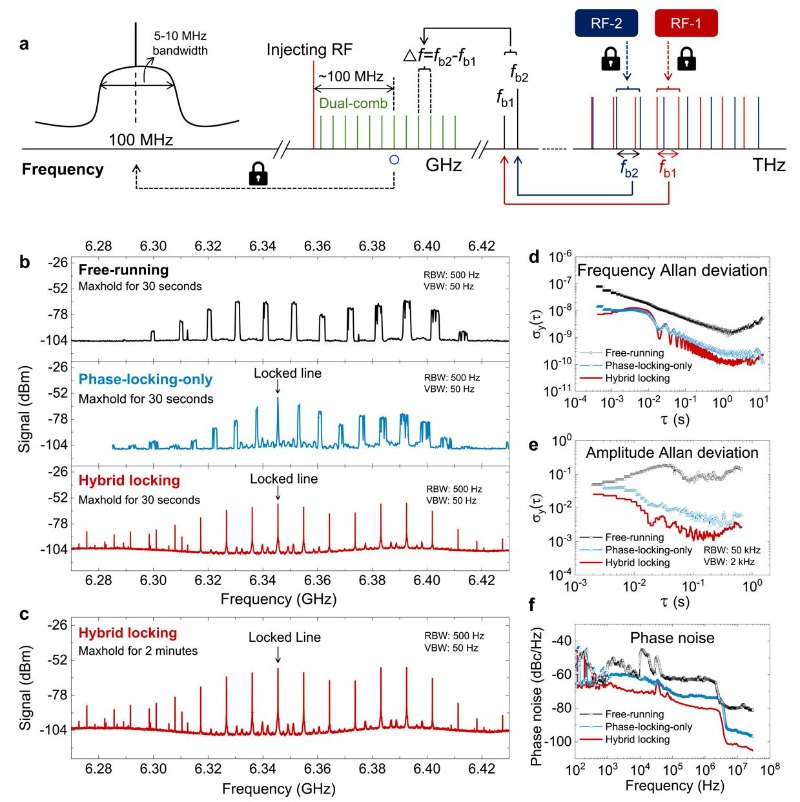Recently, the terahertz (THz) photonics group led by Prof. Hua Li at the Shanghai Institute of Microsystem and Information Technology, Chinese Academy of Sciences, collaborating with Prof. Heping Zeng at the East China Normal University and Prof. Ya Zhang at the Tokyo University of Agriculture and Technology, made a progress in the hybrid locking of THz semiconductor dual-comb sources. The research work was published in ACS Photonics on January 05 of 2024 (Yiran Zhao, Ziping Li, Xuhong Ma, Kang Zhou, Wen Guan, Chenjie Wang, Shumin Wu, Han Liu, Wenjian Wan, J. C. Cao, Ya Zhang, Heping Zeng, and Hua Li, Stabilized Terahertz Quantum Cascade Laser Dual-comb Sources with a Hybrid Locking, ACS Photonics 2024, 11, 520).
Highly stabilized THz dual-comb sources are of great importance in various applications, e.g., precision measurements, sensing, communications, etc. Based on semiconductor quantum cascade lasers (QCLs), in previous works, the THz photonics group has demonstrated self-detected THz QCL dual-comb (ACS Photonics 2020, 7, 49) and on-chip dual-comb operation (Advanced Science 2019, 6, 1900460), stability improved dual-comb sources by employing microwave double injection (Physical Review Applied 2019, 12, 044068), phase-locked loop (Laser & Photonics Reviews 2021, 15, 2000498; Advanced Photonics Nexus 2023, 2, 026006), self-referenced methods (Laser & Photonics Reviews 2023, 17, 2200418).
In this work, the research group proposed hybrid locking technique, that is to simultaneously lock the dual-comb offset and repetition frequencies by implementing microwave double injection and phase locking, respectively. Figure 1a shows the operation principle of the proposed hybrid locking method. The three locks represent the locking of two repetition frequencies and the dual-comb offset frequency. Figure 1a also schematically demonstrates the dual-comb frequency synthesis process from THz to microwave frequency range. Figures 1b and 1c show the “maxhold” dual-comb spectra measured under different conditions, i.e., free-running, phase-locking-only, and hybrid locking. It can be visually shown that the dual-comb spectra obtained under the hybrid locking condition shows the best stability. In Figures 1d-1f, we further show the frequency Allan deviation, amplitude Allan deviation, and phase noise spectra of the dual-comb signals under different conditions. It can be clearly seen that the hybrid locking can result in the optimal frequency, amplitude stabilities, and phase noise. It is worth noting that, the research group made successive progresses in “maxhold” dual-comb linewidth in the last years. The parameter was initially 2-3 MHz in free-running (ACS Photonics 2020, 7, 49; Laser & Photonics Reviews 2021, 15, 2000498), which was first compressed to 14.8 kHz by employing a self-reference method (Laser & Photonics Reviews 2023, 17, 2200418), and then further compressed to 5.7 kHz as reported in this work by implement the hybrid-locking method. The hybrid locking can effectively improve the long-term stability of THz semiconductor dual-comb sources and promote the practical applications in spectroscopy, sensing, communications, etc.

Figure 1. (a) Operation principle of the hybrid locking of THz QCL dual-comb sources. fb1 and fb2 are repetition frequencies of the two THz QCL frequency combs, which are injection locked by RF-1 and RF-2, respectively. △f=fb2-fb1 is the repetition frequency of the dual-comb signal. (b) “Maxhold” dual-comb spectra under free-running, phase-locking-only, and hybrid locking conditions measured for a time duration of 30 seconds. (c) “Maxhold” dual-comb spectrum under hybrid locking condition measured for 2 minutes. (d), (e), and (f) are plots of frequency Allan deviation, amplitude Allan deviation, and phase noise of the dual-comb signal under different conditions.
Figure 2. Cover image
This work was supported by National Natural Science Foundation of China(62325509, 62022084, 62235019, 61875220, 61927813, 61991430, 62035005, and 62105351)、the CAS Project for Young Scientists in Basic Research (YSBR-069), the “From 0 to 1” Innovation Program of the Chinese Academy of Sciences (ZDBS-LY-JSC009), the Scientific Instrument and Equipment Development Project of the Chinese Academy of Sciences (YJKYYQ20200032).

